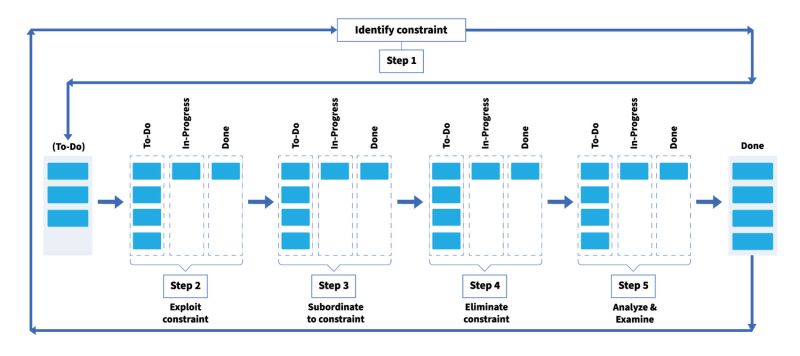
Before getting into more details about the theory of constraints and how it can be used to support work management, let’s firstly understand what constraint means.
From a broad perspective, a constraint can be understood as a limiting factor that hinders the efficiency goal of a process in any field of work. For example, in the context of businesses and administration, constraints can be seen as any factor that hampers an organization to advance towards its strategic goals. In the field of manufacturing, constraints are often associated with process bottlenecks or even with equipment misuse and malfunctions. On the other hand, in the field of project management, constraints are usually regarded as time, scope and costs of a specific project.
What is the Theory of Constraints?
Now that the concept of constraints has been introduced, you might be wondering what is the idea behind the theory of constraints. Basically, this theory assumes that there is always at least one constraint in any process. By methodically focusing on identifying and eliminating the constraint, it is possible to continuously improve the process throughput under consideration. Therefore, efforts and actions on non-constraints should be avoided whenever possible, as this does not contribute to getting advantages in the process.
The correct implementation of the theory of constraints can bring many benefits, as for example:
- Improving the process constraint helps to achieve a faster process workflow, which in turn decreases process lead times;
- Optimizing the constraint improves process capability, and;
- Process costs can be reduced.
How the Theory of Constraints Can Help You Manage Work Better
The theory of constraints allows work management by using a method called The Five Focusing Steps to identify and continuously eliminate process constraints. The Five Focusing Steps method can be combined with the Kanban method in order to manage work better, Figure 1.

Figure 1 shows the inherent cyclical characteristic related to The Five Focusing Steps method. It is possible to see that the required workflow repeats constantly over time, thus highlighting the continuous improvement feature in the theory of constraints.
Step 1. Identify the existing constraint.
This is schematically represented at the top of the digital Kanban board. The constraint, in this case, refers to the single process step that hinders the process to achieve a suitable throughput (i.e., output rate) and therefore, limits its goals. Sometimes, it is clear and easy to find the process bottleneck, nonetheless, in many situations, it could turn out to be not that simple. Digital Kanban boards can help to identify process constraints by looking at Kanban metrics, charts and the board itself.
A possible initial alternative to find a constraint is to analyze the process step that presents either the higher cycle time or higher WIP (work in progress). Process steps whose work items are waiting to be carried out, can also be considered as possible constraints. The analysis of possible patterns in the Cumulative Flow Diagram (CFD) is another valuable chance to find process constraints. If you want to learn more about the CFD chart, take a look at the article How to Optimize Workflow Efficiency without Team Overburden.
Step 2. Exploitation of the constraint.
This step involves checking whether the constraint is being used at its full capacity. In other words, this step is about getting quick improvements concerning the constraint throughput, with available resources. Digital Kanban boards can support the constraint exploitation for example, by adjusting or reducing the WIP limits of the critical process step.
Step 3. Subordinate the constraint.
After identifying and exploiting the process constraint, it is time to subordinate all the other non-constraint process steps to support and improve the process constraint (Figure 1, Step 3). Making use of digital Kanban boards to review whether the work items in the process are supporting the process constraint is a suitable alternative in this method’s step.
Step 4. Eliminate the constraint.
The fourth step of the method consists in taking further actions to eliminate the process constraint, in case it still exists. Normally, changes in the existing process are required at this step of the method as well as resource investments, as for example, regarding equipment, team training, etc. The Kanban method can help here through appropriate tools and software. Team feedback from brainstorming meetings aiming at new solutions to tackle the constraint is also contemplated in this step of the method.
Step 5. Analyze and examine.
Once the process constraint seems to have been eliminated, in the fifth step of the method, it is necessary to examine if that fact is really true (Figure 1, Step 5). Digital Kanban boards are good tools to accomplish this task, by evaluating the actual process throughput and comparing it to the previous value. Should the process throughput show a higher value than before, that means the process constraint was fixed and the first step of the method must start again, aiming at constant process improvement.
Combining the theory of constraints with the Kanban method can work wonders in terms of identifying process constraints. Additionally, the elimination of the process constraint allows process improvement as well as better work management, by solving the root causes concerning the constraint.
Learn to Work Smarter, Not Harder!
Get our top articles weekly.
Table Of Contents
Discover many more posts…






